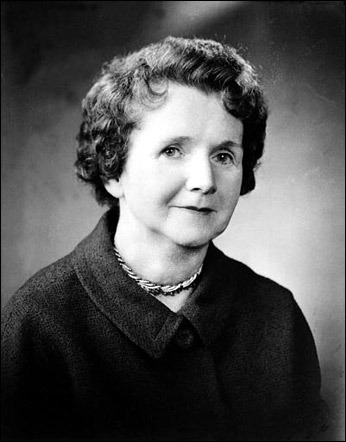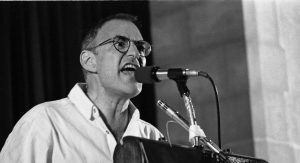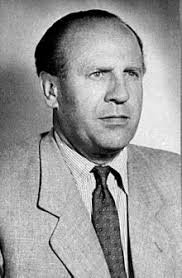Whenever one thinks of a real-life hero, one thinks of firefighters or policemen or even sometimes nurses. But we rarely imagine environmentalists as being heroes in our society. But Rachel Carson, an environmentalist who fought against chemical industries, is certainly one of our truest of heroes. She fought to preserve and protect both wildlife and our environment from the harmful effects of pesticides, such as dichlorodiphenyltrichloroethane (DDT) and malathion. Her goal was to bring about a DDT-free world and she did accomplish that goal. But sadly, she wasn’t able to see her work and the effect she left on modern ecology.
DDT was a pesticide widely used from the 1940s until the 1960s. It was first used by the United States military as a way to control diseases such as malaria, typhus, and body lice during WWII. And at first, DDT was able to decrease the number of malaria cases from 400,000 to close to zero.1 The reason that DDT was so effective was its ability to remain in its targeted environments for long periods of time. In addition, the pesticide was loosely regulated, which meant that it could be overused and sprayed in large quantities. As United States farmers adopted the use of DDT, they failed to realize one grave reality: insects were developing a resistance to DDT. As DDT usage grew in the United States, its contamination to the environment increased drastically.

One of the main advocates for educating people about the dangers of DDT was Rachel Carson. Carson was born in May of 1907 and grew up to become one of the most important and crucial environmentalists in the twentieth century. Her journey began during her childhood. Carson spent countless hours in the outdoors and showed her true potential as a writer by writing short stories during her time in the outdoors. She enrolled in the Pennsylvania College of Women as an English major in 1925. However, she switched her major to both zoology and marine biology, thanks to her influential biology professor, Mary Scott Skinker.2 She developed a passion for science. Shortly after graduating in 1929, she went on to earn a master’s degree in zoology from Johns Hopkins University in 1932. She continued her studies in the Marine Biological Laboratory (MBL) located in Woods Hole, Massachusetts.3 After a short time in MBL, Carson moved to a job in the Fish and Wildlife Services (FWS). Rachel Carson didn’t know it at the time, but her job at Fish and Wildlife Services would be the start of her career as a writer and as an environmentalist.
During her time at FWS, she wrote pamphlets, short essays, and newspaper articles about nature. In her career in FWS, Carson wrote to the public about nature, but her reading audience at the time was really small.4 At the same time, she was spending time researching the organisms on the East coast shores of the United States. She was gathering information that she used for her first three books, Under the Sea Wind, The Sea Around Us, and The Edge of the Sea.5 These books laid down the foundation from where she would have enough experience and large enough audience to make an impact.
In 1957, Carson began to notice certain aspects of the environment that were changing. More specifically, the numbers of the grebe population in Clear Lake was decreasing at an exponential rate.6 These grebes were breeding birds that were occasional winter visitants in Clear Lake that were mostly attracted to the abundance of fish in the lake.7

Over the course of the years, as DDT was being sprayed to control the population of the gnat, the population of grebes began to dwindle by the hundreds. More and more grebes were found dead and it all pointed back to the spraying of DDT. And as it was sprayed, smaller organisms began to pick up the poison and was passed down to larger predators such as the grebes and the fish they ate in Clear Lake.8 After further examination, it was found that DDD, a metabolite of DDT, was found in the visceral and subcutaneous fat tissues in both grebes and other bird species such as California gulls.9 In these animals, the concentration was able to reach two thousand parts per million, which is a high concentration of DDD in the organism.10 After seeing that the chemical industry was not taking responsibility for their actions, Carson began to research other events that might be related to the incidents that she first witnessed in Clear Lake. And so, this was how Rachel Carson was inspired to write Silent Spring and what led her to start the modern ecological movement.
In Silent Spring, Carson begins by describing “a town in the heart of America” where all the plants delighted the viewer’s eye and people traveled great distances to watch the bird diversity there. She then places the pesticides being sprayed as a “strange blight” that crept over the poor town and portrayed the blight as an evil spell.11 This evil spell caused the animals, such as cows, sheep, and poultry, to die and created a shadow of death nobody was able to escape. It made the town people ill and puzzled the doctors as to what was happening to their patients. The “blight” would cause sudden and unexplained deaths that struck farming families. And the town would also suffer even more deaths when children who were playing outside were exposed to the “blight,” and within a few hours, the children who were perfectly healthy had died from pesticide poisoning.12 In the outskirts of the town, the blight had also affected the birds by decreasing their populations to only a few, and it made the few birds that were left look like they were about to die. Overall, these effects caused there to be a spring with no voices. It created a silent spring that was full of death and unending silence. And although this town did not indeed exist, Carson pointed out that the events that took place in the town had actually happened in the United States and other places around the world.13
Silent Spring was published in 1962, but it took Carson about four years to finish writing and publishing Silent Spring. But she had an uphill battle to getting Silent Spring published. After finishing a book, an author normally sends a copy of the book to a publisher and the publisher will decide if the book should be published. In Rachel Carson’s case, her book kept on getting rejected by numerous publishers, because of the material that Silent Spring contained. The reason why many of the publishers refrained from publishing Silent Spring was because they feared that they would lose advertising revenue from chemical industry companies. And at the time, divulging negative ideas about the chemical industry was rarely noticed by the U.S. population. This was mostly due to the fact that the chemical industry was able to save millions of lives from terrible diseases such as malaria and typhus through the spreading of their pesticides. And plus, it was really dangerous to target the chemical industry because it was huge and had a great deal of influence on the American people. But luckily, after all her tries and waiting for several weeks, a publisher in Houghton Mifflin, today known as Harcourt Publishing, took a risk and decided to publish Silent Spring.
However, before the book was published, the American public was not aware of the toxicity of pesticides. And the chemical companies intended to keep it that way. Essentially, if the book was allowed to gain a national audience, the government might be pressured by the public to implement certain regulations on the chemical companies. So, the chemical companies saw a moment of opportunity where they began attacking both Carson and her unpublished book Silent Spring. They slandered her image by calling her a hysterical woman and a scientist with communist values, which at the time was a major accusation because of the Cold War, which was at its height. They even attempted to discredit both Rachel Carson and her findings in Silent Spring.14 And as expected, the chemical companies threatened to pull ads from newspapers and magazines that might give positive reviews of Silent Spring.15 But it would soon turn out that these attempts would backfire and it would have the opposite effect that the chemical companies intended to have on Silent Spring.16 As the attacks continued, more attention was drawn to Carson as the woman that was standing against the whole chemical industry, and that made Silent Spring extremely popular across the whole country.

Shortly after publishing Silent Spring, the American audience began to realize how dangerous unregulated pesticides could be. It even caught the attention of President Kennedy’s administration and they were the ones who began the official research on whether the claims of Carson on DDT were true or not. The President’s Science Advisory Committee (PSAC) was appointed to conduct research to establish whether there were any concerns over “human health illness from pesticides,” but they still were encouraged “to increase public education about biohazard of pesticides.” 17 And by June 4, 1963, a Congressional hearing was held on the subject of DDT and Rachel Carson was invited to speak in the hearing. There she would make her debut and would open American minds to how humankind had chosen to ignore how we were contaminating the environment with harmful substances. But it was not until 1972 that DDT was banned from being used in U.S. agriculture. Although Rachel Carson created a significant impact in ecological history, she was not able to see what Silent Spring had caused since she passed away from a heart attack only two years after Silent Spring was published.
Today, Silent Spring is regarded as the spark of the modern environmental movement, and Rachel Carson is remembered as one of the best scientific authors. In her book, Rachel Carson was trying to communicate with the American people about how she showed concern for their well-being. But the most important part was that she was able to integrate a sense of humanity to her text. 18 This is what set Silent Spring apart from other books at the time, and it is what made her one of the most important authors of the twentieth century.
- Encyclopedia Britannica, October 2015, s.v. “DDT,” by Thinley Kalsang Bhutia and Gloria Lotha. ↵
- Salem Press Biographical Encyclopedia, s.v. “Rachel Carson (1907-1964).” ↵
- Salem Press Biographical Encyclopedia, s.v. “Rachel Carson (1907-1964).” ↵
- U.S. Fish & Wildlife Service, “Rachel Carson: A Conservation Legacy,” Office of External Affairs. https://www.fws.gov/rachelcarson/ (Accessed April 11, 2018). ↵
- P. L. Thomas and Karen F. Stein, “Speaking Truth to Power: The Legacies of Rachel Carson,” The English Journal, no. 6 (July 2014): 81-84. ↵
- Rachel Carson, Silent Spring (Boston, MA: Houghton Mifflin Company, 2015), 47. ↵
- Rachel Carson, Silent Spring (Boston, MA: Houghton Mifflin Company, 2015), 47. ↵
- Rachel Carson, Silent Spring (Boston, MA: Houghton Mifflin Company, 2015), 47. ↵
- U.S. Geological Society, “Western Grebe,” Biological and Ecotoxicological Characteristics of Terrestrial Vertebrate Species Residing in Estuaries. https://www.pwrc.usgs.gov/bioeco/wgrebe.htm (Accessed April 13, 2018). ↵
- Rachel Carson, Silent Spring (Boston, MA: Houghton Mifflin Company, 2015), 48. ↵
- Rachel Carson, Silent Spring (Boston, MA: Houghton Mifflin Company, 2015), 1. ↵
- Rachel Carson, Silent Spring (Boston, MA: Houghton Mifflin Company, 2015), 27, 1, 2. ↵
- Rachel Carson, Silent Spring (Boston, MA: Houghton Mifflin Company, 2015), 2. ↵
- Brian Payton, “Rachel Carson (1907-1964),” NASA Earth Observatory. https://earthobservatory.nasa.gov/Features/Carson/Carson3.php (Accessed April 13, 2018). ↵
- Brian Payton, “Rachel Carson (1907-1964),” NASA Earth Observatory. https://earthobservatory.nasa.gov/Features/Carson/Carson3.php (Accessed April 13, 2018). ↵
- Brian Payton, “Rachel Carson (1907-1964),” NASA Earth Observatory. https://earthobservatory.nasa.gov/Features/Carson/Carson3.php (Accessed April 13, 2018). ↵
- Douglas Brinkley, “Rachel Carson and JFK, an Environmental Tag Team,” Audubon (May 2012), http://www.audubon.org/magazine/may-june-2012/rachel-carson-and-jfk-environmental-tag-team (accessed March 2, 2018) ↵
- U.S. Fish & Wildlife Service, “Rachel Carson: A Conservation Legacy” Office of External Affairs. https://www.fws.gov/rachelcarson/ (Accessed April 11, 2018). ↵



12 comments
Brianna Ramos
Rachel Carson was not a name I knew about in history, but I had heard of DDT before. Firstly, it’s crazy how we just used this new pesticide so freely and in large quantities. Secondly, the fact that the insects were so quick to evolve and build up resistance to this over a 20 year span just speaks to how incredible nature and our world is. Lastly, it’s just wild to me that back then the public believed and hardly questioned what was going on. The advertisement of the food and people singing that “DDT is good for me!” makes me cringe, but also grateful that people like Rachel Carson were there to stop this and pave a way for environmentalists today.
Eric Ortega Rodriguez
Let me start off by saying that this article is very well written. Before reading this article, I had no idea on who was Rachel Carson or of her involvement with DDT. This article does a good job explaining and allowed me to view Rachel Carson as a warrior for standing up against the huge chemical companies. She wanted to care for human kind, she should be viewed as a role model as someone who deeply cared about humans and wildlife. Overall, this article was great. Good work.
Clarissa Gonzalez
Rachel Carson was almost an entire unit in my environmental science class last year. My teacher had spoken about her so highly and Silent Spring was an must read for her class. Reading this article was like a throwback into what I was learning last year and was just as interesting at the first time. This woman brought so much light to what pesticides could really do to the environment and its amazing!
Steven Hale
The advertisement with the cow and apple is comical and ridiculous. I don’t think I have ever seen a pesticide commercial, and it seems like the public has a general aversion to pesticides-even ones that are supposed to be harmless. We have all kinds of “natural” or “non-treated” foods available to us today and most of that is because of Carson. It’s incredible to think of the impact she’s still having so many years after writing Silent Spring.
Gabrien Gregory
This is a well-written article about one of the founders of the environmental movement. I really enjoyed the introduction of the article, as we do not typically view heroes as more than those in uniforms. What I find most impactful about this reflection is the wave created in the United States after reading Silent Spring. Although it started a movement, we still have much work left to do to limit climate change’s destruction through anthropogenic factors, such as pesticides and chemicals. This is a topic everyone should read, and I would encourage them to lead by Carson’s example for future generations.
Bictor Martinez
I have heard of DDT, but not about the amount of damage it did in our environment. Rachel Carson is one brave woman who tried to save thousands of people while fighting large chemical companies. People were so brainwashed of the chemical situation back then, however people needed to know the truth and thanks the Rachel, people snapped out of it and began to join the movement. Rachel went against all odds in trying to publish her book and she did. She kept fighting and is a great example of never giving up.
Mariah Cavanaugh
First of all, YES to amazing women making a difference! This was my first introduction to Rachel Carson and DDT. Her book, Silent Spring sounds fascinating, and I am adding it to my list of books to read eventually. It is not surprising that the chemical companies retaliated against papers that supported Carson’s book, it felt good to see that she did not back down. You did a great job with this story.
Harashang Gajjar
The article above that Carson may have the long view but it was certainly convenient for scientists to hold off on spraying until serum analysis yielded trace presence in our own population. A short time later our decision became malarial Africa’s and thousands of individuals sufffered and died annually. Now the concern with antibiotics. Hope we don’t stop one treatment before the next short fix begins, we may not be so comfortable this time. Anyway, what difference does it make if chemicals slowly fail if it contiues to save some lives. Not to have made the chemical available was the ultimate failure.
Eric Ortega Rodriguez
In middle school, I remember talking about DDT and the negative consequences that came along with it. However, I had never heard of Rachel Carson or of her involvement to end DDT. This article was very informative, and it allowed me to view her as a hero. She was not afraid to go against the chemical companies, which were very powerful at the time. Her intent was to look out and care for humanity and wildlife. Reading about the harm that DDT was causing the grebe population, I can’t imagine how damaged the world would be today if it wasn’t for Rachel Carson who took a stand to end DDT.
Regina De La Parra
I take very seriously taking care of the environment and buying from companies that believe this is important as well. I am really glad to learn about yet another amazing woman who has done something for the benefit of everyone. I wish I had known about Rachel before, but now that I have, I will definitely share her story with my friends. Thanks for writing about such an important woman Hector!